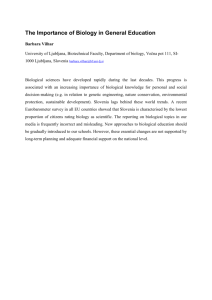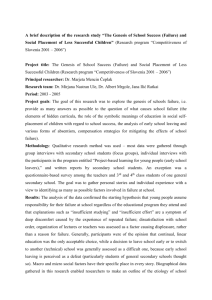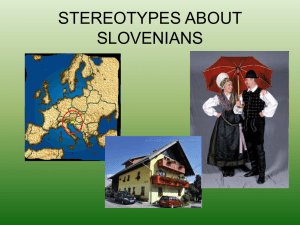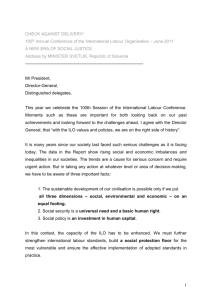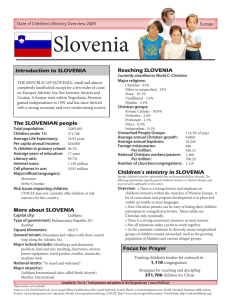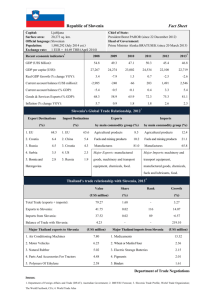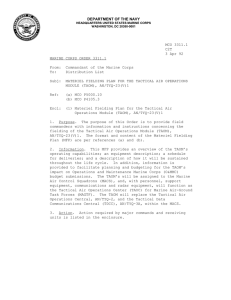Financování výtvarného umění: Pohled na projekt Percent for Art
advertisement
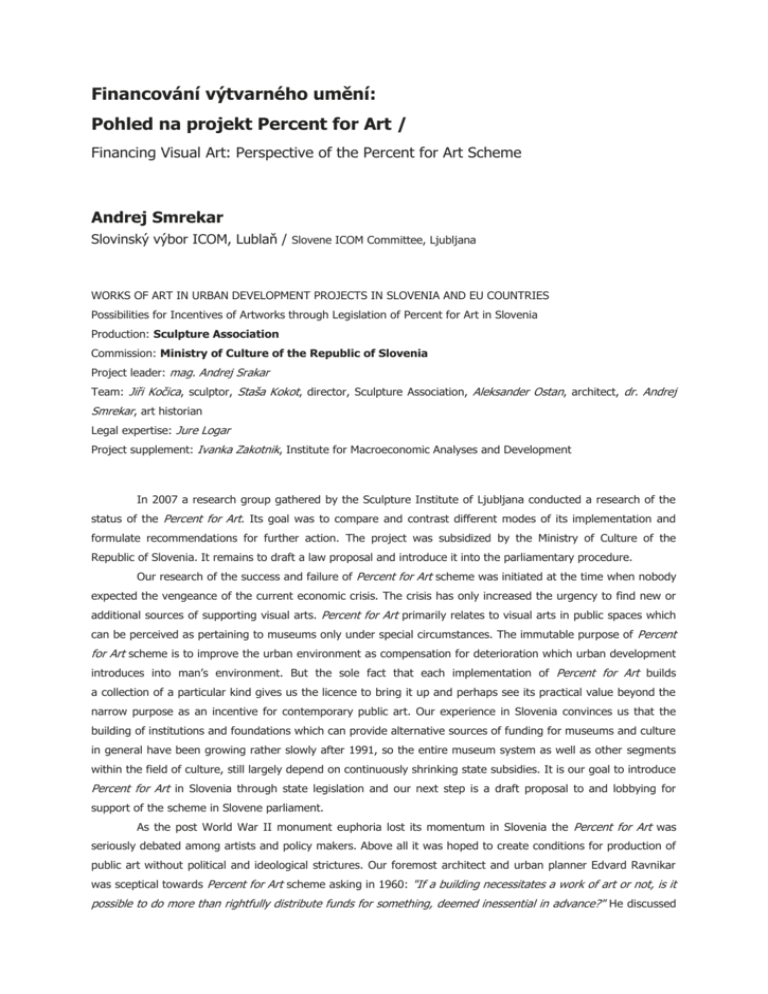
Financování výtvarného umění: Pohled na projekt Percent for Art / Financing Visual Art: Perspective of the Percent for Art Scheme Andrej Smrekar Slovinský výbor ICOM, Lublaň / Slovene ICOM Committee, Ljubljana WORKS OF ART IN URBAN DEVELOPMENT PROJECTS IN SLOVENIA AND EU COUNTRIES Possibilities for Incentives of Artworks through Legislation of Percent for Art in Slovenia Production: Sculpture Association Commission: Ministry of Culture of the Republic of Slovenia Project leader: mag. Andrej Srakar Team: Jiři Kočica, sculptor, Staša Kokot, director, Sculpture Association, Aleksander Ostan, architect, dr. Andrej Smrekar, art historian Legal expertise: Jure Logar Project supplement: Ivanka Zakotnik, Institute for Macroeconomic Analyses and Development In 2007 a research group gathered by the Sculpture Institute of Ljubljana conducted a research of the status of the Percent for Art. Its goal was to compare and contrast different modes of its implementation and formulate recommendations for further action. The project was subsidized by the Ministry of Culture of the Republic of Slovenia. It remains to draft a law proposal and introduce it into the parliamentary procedure. Our research of the success and failure of Percent for Art scheme was initiated at the time when nobody expected the vengeance of the current economic crisis. The crisis has only increased the urgency to find new or additional sources of supporting visual arts. Percent for Art primarily relates to visual arts in public spaces which can be perceived as pertaining to museums only under special circumstances. The immutable purpose of Percent for Art scheme is to improve the urban environment as compensation for deterioration which urban development introduces into man’s environment. But the sole fact that each implementation of Percent for Art builds a collection of a particular kind gives us the licence to bring it up and perhaps see its practical value beyond the narrow purpose as an incentive for contemporary public art. Our experience in Slovenia convinces us that the building of institutions and foundations which can provide alternative sources of funding for museums and culture in general have been growing rather slowly after 1991, so the entire museum system as well as other segments within the field of culture, still largely depend on continuously shrinking state subsidies. It is our goal to introduce Percent for Art in Slovenia through state legislation and our next step is a draft proposal to and lobbying for support of the scheme in Slovene parliament. As the post World War II monument euphoria lost its momentum in Slovenia the Percent for Art was seriously debated among artists and policy makers. Above all it was hoped to create conditions for production of public art without political and ideological strictures. Our foremost architect and urban planner Edvard Ravnikar was sceptical towards Percent for Art scheme asking in 1960: "If a building necessitates a work of art or not, is it possible to do more than rightfully distribute funds for something, deemed inessential in advance?" He discussed the prospects of public art and called for a new synthesis that would transcend the post-renaissance concept of integration of the arts. Although unable to describe such synthesis he attributed the fact that sculptures or monuments ended up as deposits on green strips on the edges of squares to emancipation of architecture that had reduced other arts’ intervention to decoration thus rendering them unnecessary. Ravnikar developed a plan in 1960 for the Square of the Revolution in Ljubljana, the national capital of Slovenia, in which the main compositional axis stretched from the entrance to the existing parliament building to the monument to the revolution flanked by two towers. As the square was brought to completion in 1974, i. e. after the economic crisis and reformation of the economy, the monument was deposited on a green strip at the edge of the square. Ravnikar thus demonstratively agreed to relocation to make his earlier theoretical point of “the inessential, unnecessary, for its own sake” art. As far as his attitude to the Percent for Art scheme is concerned, it seems that the interpretation at the time was too rigid tying the percent for art to the specific project. In that case, in the same way, a piece of public art was indeed something that by the logic of “the least damage” had to be left anywhere on the premises covered by the project that had generated the proscribed percentage. Such interpretation was not exceptional as later developments can prove. This rather old concept often sneered at by the elitists, or treated with scepticism within various cultural policies, has gained a momentum only during last two decades of the twentieth century in the United States and several countries of Western Europe and Scandinavia. Two points were instrumental in gradual success of the scheme: the adequacy of criteria of success and the awareness of sensitivity and complexity of the public space. As long as the criteria were universal and defining only artistic quality, such a scheme stood no chance. That was the meaning of the “unnecessary art” described by Ravnikar − and that is the meaning of a definition reiterated recently in New York Times that the best public art is the one we do not notice. But public space is not the white cube, the privileged gallery space intended only for aesthetic contemplation and enjoyment, because it includes many other aspects of the formal and social context which must be taken into account. It therefore cannot be left just to the artist and the architect to make decisions about a project but also the patron, who ultimately has to secure maintenance, as well as the inhabitants and other individuals who use the public space. The set of criteria to measure the success with is more complex and artistic quality, although very important, is not the principal one among them. Most spectacular developments in art for public spaces have taken place in New York City. The scheme was implemented in 1982 as the newly elected president Reagan drastically cut funding for National Endowment for the Arts. Projects like the Tilted Arc by Richard Serra helped us understand the sensitivity of the use of public space. In this notorious case the artistic freedom clashed with the interests of the people working in the neighbouring buildings. The seventy-three ton Cor-Ten steel plate blocked Federal Plaza thus policing by-passers to use its edges. Lunch time was never the same for the working people in the area after the barrier halved the square surface on which people used to sit and take the sun during their lunch breaks. After eight years of controversy the sculpture was removed. The Court decided to keep one person mad instead of hundreds or even thousands. The complexity issue was demonstrated in conceptual land-art pieces by the Bulgarian born artist Christo, famous for projects like wrapping a part of the Australian Coastline, Berlin’s Reichstag, building a 32 mile Running fence California or hanging a curtain across a valley in Rifle, Colorado. The Saffron Gates project was conceived in 1979 for the Central Park of New York and realized only in 2005 after twenty-six years of negotiations with the city authorities, collecting money and adjusting the project to the requirements of safety, environment protection etc. It is a completely different case, fore the 7.500 gates four metres high, elevated along some 37 km of paved paths, were financed by the artist and removed after sixteen days. The project was warranted by a 43 page contract. This experience was instrumental in formation of the committees that make decisions in the process of selection and execution of projects within the Percent for Art scheme. They work best when they include representatives of all the stakeholders in the public space in question. While Serra's project urged the inclusion of stakeholders, Christo worked out a way of negotiating between the authorities, artists and communities. Schemes in different countries vary to considerable extent. The idea has been conceived in the Weimar Republic but bore no fruit since the public space was soon filled with social projects sponsored by central governments in response to the economic crisis following the New York Stock Exchange crash. The scheme took root first in Sweden Norway and the United States during 1930s. Germany, Italy, France, Great Britain, Finland, The Netherlands, and Canada (1964) followed the suit after the Second World War. In our research we examined the scheme in Austria, Finland, Germany, The Netherlands, Norway, Sweden and United Kingdom by means of a questionnaire. The practices in the United States, Sweden and Denmark have also been broadly publicised and the web offers a lot of information on specific cases. It is interesting how terminology changed in the process of urban reconstruction of the cities: during 1960s revitalization, 1970s reconstruction, 1980s re-planning and 1990s regeneration. Permanent development and public / private partnerships are the call of the day now. Percent for Art is often introduced on national level as a recommendation as for instance in Great Britain, The Netherlands, in most of the Scandinavian countries and in United States. These countries leave it to local communities – provinces or municipalities – to manage the improvement of urban spaces on their own. Less frequently it is regulated by state legislation and among those countries I can quote Austria, Canada, France and Italy. Austrian federal law implements it on the national level only for development projects financed by the federal institutions and does not legally bind private development initiatives. However, the province of Lower Austria implemented the all encompassing scheme on regional level with far reaching results. We have decided to implement the latter model in Slovenia since it seems more reasonable for the size of our country which is rather small. The quantification of Percent for art derived from development projects varies considerably. It can be anywhere between 0,5 % to 2 %, even 5 % but on average it is close to 1 %. Just as well it usually decreases with the size of the capital development cost and very often it has at least the upper limit. New York for instance limits the allocation of Percent for Art to 400.000 $. Our research has shown that the most successfully managed schemes do not necessarily tie the allocation of money to the project from which they derive. The funds are available to the broader area which contributes to more rational use and management of the public space. In this way it mimics taxation but with a specific and limited purpose. By the same token it is also uniformly organized which imposes on it a pattern of collection building. Our primary interest was what have participants learned from their experience? Majority was satisfied with results derived from the scheme, particularly in Lower Austria and Norway, our colleagues in Germany and Finland wished for greater involvement of the state. In The Netherlands a serious threat was detected from appetites for privatization of development projects, while in Finland the impact of public art project has not quite met the expectations on local level. The most important recommendation for the implementation of the scheme by the practitioners was to stick to the principle of the “arms-length distance”. That means that the decision making process should be strictly separated from state institutions. The Austrians emphasised also the importance of mediation and negotiation before the project enters the actual public space. These responses were crucial for adoption of the Lower Austrian model in Slovenia. Besides the similarity of the legislation in the two countries, members of our research group agreed that the exploitation of the Percent for Art scheme for fuelling a trust fund could contribute to the more reasonable distribution of works of art in public space. It absolves the developer of inclusion of something he would have to invent himself or accept from the outside in the course of execution. It gives artists and stockholders a chance to identify and study particular location and develop a solution based on existing facts. In this way it is possible to maintain greater control of the usage of public space and negotiate it with everybody involved, which is crucial for the success of any public art project. Since increasingly more productive implementation of the scheme in various countries from early 1980s on the impact studies have developed to a considerable extent. Figures such as 10 % increase in hotel occupancy, doubled business in restaurants in vicinity, Broadway tickets sales increase by 17 %, museums substantially increased attendance, push-cart and hubby operators ten times increased their earnings, 600–700 workers employed, by the Saffron Gates project while the city announced 4 million attendants generating 254 million $ for the New York City. It is self-evident that the legislators want to warrant their decision by the benefits that public funding exacts in social environment. We have included in our research project an input-output study based on internationally accepted methodology developed by the institutions of the United Nations and of the European Union. Simulation of two scenarios were calculated at 0,5 % and 2 % of input into the scheme. It is self-evident that greater input produces greater impacts in the national economy. Although there is a danger that the effect is also negative and that would happen if public funds were diverted from another sector with greater multiplying effect. But that is not very likely to happen because the culture sector has itself relatively very high multiplying effects. Besides the economic impact we should count in other effects that have been identified in practice so far as well. These effects are symbolical but nevertheless very important for the patron, the artist and the community. Most of the artistic projects in public space have stimulated the interest in visual arts, upgraded the education level, instilled greater sense of identity and pride of the community, improved the quality of living environment, stimulated intercultural dialogue, etc. Looking for alternative sources to support culture today The Percent for Art scheme seems a promising instrument of raising funds for public activities. Moreover, as certain economists identify the economic problems within the field of culture, they recommend financing the offer side instead of demand side of the economy of the arts. The Percent for Art scheme is close to ideal to bolster the demand side of the cultural production. That is not to say that straight subsidies for the individuals such as grants, scholarships, internships etc. should be abolished. They recommend that most of the investments into culture production should be disbursed through identification of a need. That approach would elevate the standard of quality in artistic production intended for public space. As the collections of art works in public spaces are growing, it is only the matter of time for the scheme to be urged to respond to the maintenance and management requirements of collections that are taking shape. Regeneration of public art witnessed in our time is perhaps the answer to the call of Edward Ravnikar for a new integration of the arts. It does not represent only the integration of the art and architecture, it also fosters the integration of the artist, patron and the audience in a heretofore unknown way through dialogue and cooperation. It involves experts such as art critics, designers, architects, urban planners, representatives of the governing bodies, engineers, and more importantly representatives of the community that would benefit from a proposal. I believe that the Tilted Arc had site. a chance to stay, were it negotiated instead of imposed onto its Resumé V roce 2007 provedla výzkumná skupina zorganizovaná Sochařskou asociací z Ljublanje (Slovinsko), průzkum o důležitosti projektu Percent for Art: procento nákladů programů pro městský rozvoj, vyhrazených na zlepšení kvality života v městské prostředí. Cílem tohoto průzkumu bylo srovnat a prozkoumat rozdíly mezi různými způsoby jeho realizace a formulovat doporučení pro další kroky. Zbývá jen vypracovat návrh zákona a předložit ho k projednání v parlamentu. Projekt Percent for Art byl často přijímán se skepsí, avšak v posledních dvou desítiletích byl úspěšně realizován v několika zemích ve Skandinávii, západní a střední Evropě a také v Americe. V době snižování dotací přidělovaných umění a kulturním aktivitám v nejširším slova smyslu se projekt Percent for Art zdá slibnou alternativou, která by mohla zajistit další financování výtvarného umění v zemích, ve kterých projekt dosud nebyl realizován. Pro pozdější pozitivní vývoj jsou nejpodstatnější dva závěry, ke kterým se dospělo během poměrně dlouhého časového období. Prvním z nich je, že cíle financování jsou omezené. Dosud mohly být veřejné prostředky vyplaceny na umělecké projekty ve veřejném prostoru, proto by měli umělci a veřejnost spolupracovat na společném cíli. Druhý náleží kritice umění. Podmínky veřejného prostoru nemohou být ztotožňovány s podmínkami platnými pro „bílou krychli“ – galerii, muzeum. Kritéria úspěchu tak nezáleží pouze na umělecké kvalitě. Našli jsme řešení, upravené v Dolním Rakousku, které je pro náš specifický účel nejlepší. Získané prostředky nejsou nutně vázány na projekty, na které byly poskytnuty, ale jsou přidělovány podle potřeb komunity. Výhoda tohoto řešení souvisí s vybíráním cíle, protože se zde z ekonomického hlediska nedotuje výrobní strana, ale strana poptávky. Stále častějšími se stávají doporučení ekonomů, že zejména v době ekonomické recese by dotace obecně měly být přesměrovány co nejvíce na poptávku. Protože tímto způsobem vznikají nové sbírky se specifickými požadavky na spravování a údržbu, je nutné nezapomínat plánovat také financování jejich správy: nejen pojištění jejich hodnoty, ale také proti vandalismu, veřejnou bezpečnost, technologicky náročnou údržbu a restaurování, atd. Stojí za to promyslet si možnost managementu financování takovýchto sbírek ze stejného zdroje. Muzeologická odbornost, která v našem projektu chybí, by měla být začleněna do přípravy právních předpisů.
